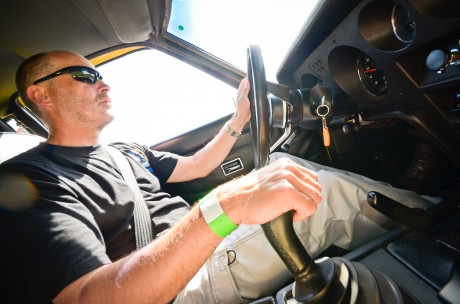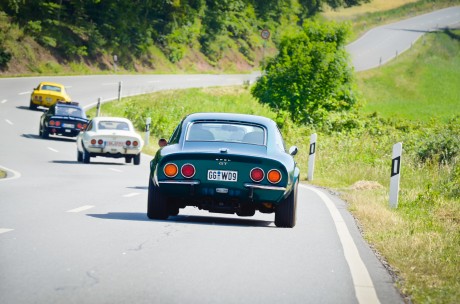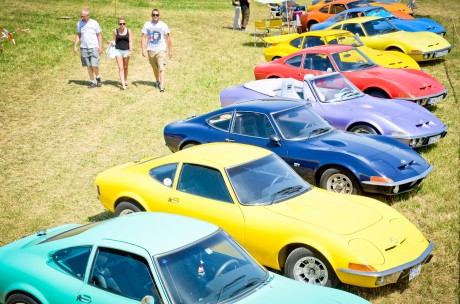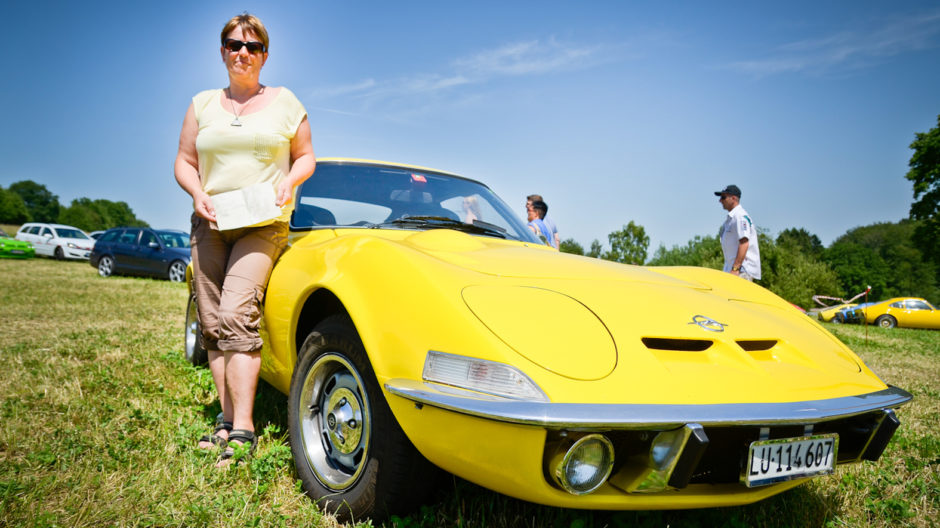- Was macht sie aus, die Liebe zum GT, wann fing sie an, und welche Formen hat sie über die Jahre angenommen? Ein paar Besucher des Opel GT Europa Treffens 2014 erzählen. Den Anfang macht…
- …Jürgen Hofmann mit seinem weißen GT 1900: „Der GT war 1985 mein erstes Auto. Und das war natürlich die Krönung des Wahnsinns, so was als Fahranfänger. Normalerweise war ja das erste Auto günstig und leicht motorisiert, meine Kumpels fuhren Kadett mit 45 PS. Ich wollte eigentlich viel lieber Motorradfahrer werden. Aber dann sah ich an einer Tankstelle dieses rote Auto neben einem B-Manta stehen. Ich war 17 und…
- …mit dem Moped unterwegs, ich wusste erst gar nicht, was das ist, aber ich wusste gleich: so einen muss ich auch haben. In der Zeitung habe ich dann ein ganz schlichtes Inserat gefunden: GT, außen weiß, innen rot. Dieses Auto habe ich mir gekauft, und ich habe es heute noch. Es ist aber nicht dieser hier. Der Erste ist mit mir durch die wilden Achtziger gegangen und er hat alles bekommen, was man…
- …damals so machte: Spoiler, Schweller, Sidepipes, Sechszylinder. Bleibt auch alles dran. Das gehört zu dem Auto, und es ist auch ein Teil der GT-Geschichte überhaupt. Auf dieses Auto hier bin ich vor fünf Jahren gestoßen. Es ist Baujahr 1969 und völlig unrestauriert, eine Rarität also. Und eben ganz genau so wie mein erster GT damals war. Ich konnte nicht anders.“
- Auch Gerald und Uschi Weber sind stolz auf ihren GT, einen fliederfarbenen Roadster. Dazu Gerald Weber: „Erstens hatte ich als junger Bursche 1985 nicht so viel Geld. Zweitens war der GT ein toller Sportwagen. Und drittens wäre was anderes als ein Opel sowieso nicht in Frage gekommen. Mein Vater war Opelaner, meine Mutter, mein Bruder ebenfalls, und ich arbeite auch dort, in der Getriebeentwicklung. Den GT habe ich mir von meinem ersten ersparten und verdienten Geld geleistet. Er war erschwinglich und ich von der Form sofort fasziniert. Wenn ich…
- …nur die Silhouette von der Seite sehe, geht es mir gleich besser. Ich weiß noch genau, wie viel ich bezahlt habe: 5600 Mark für das 14 Jahre alte Auto. Ziemlich bald startete die erste heftige Umbauphase mit all dem, wo man heute sagt: um Himmels Willen! Wer heute zum GT findet, geht ja meist in Richtung Originalität, manchmal auch schon Wertanlage. Aber damals war es eben so mit breit und bunt und viel Plastik. 1991 habe ich das Auto komplett restauriert, zwei Jahre lang habe ich jeden Tag daran gearbeitet. Ursprünglich war es…
- …mal ein 1900er, seitdem aber hat er 2,4-Liter Motor und halt kein Dach mehr. Ich hatte ein GT-Cabriolet gesehen vorher und mir dann nächtelang Gedanken gemacht, ob und wie das zu machen wäre. Damals hatten wir mit dem GT-Club Rüsselsheim gegenüber Opels H-Bau eine kleine Halle gemietet, und da hat jeder jedem geholfen. An Farbe und Innenausstattung hat meine Frau mit gestaltet.“
- Auch dabei war Marco Lana mit seinem 69er GT mit Anhänger-Kupplung: „Diesen Silbernen habe ich vor 13 Jahren gekauft. Es ist mein dritter Opel GT, und ich werde mich nie wieder von ihm trennen. Angefangen hat das mit dem GT und mir vor 20 Jahren. Da hatte ich einen GT in Teilen gefunden, und ich dachte, das bekomme ich schon hin. Aber wenn ich meine Teile mit Fotos anderer GT verglich, da sah ich immer große Unterschiede. Ich fragte mich: Warum nur sieht alles so anders aus als bei den anderen? Zwei Erklärungen waren: Meiner hatte…
- …eine Hinterachse von einem Jaguar und einen Sechszylindermotor, dafür aber keine Schottwand mehr. Ich bekam es also nicht hin. So kam ich zum zweiten GT. Der war aus Amerika und sah wirklich schön aus. Kein Rost. Aber viel Spachtelmasse, wie ich bald entdeckte. Es war ein schlecht…
- …reparierter Unfallwagen, den ich nicht behalten wollte. Also Nummer drei. Drei Jahre habe ich mit Hilfe eines Lackierers die Karosse in Schuss gebracht, er half mir, ich half ihm, so ging das. Mit der Zeit bekam der GT 16-Zoll-Felgen von Borbet, eine Klimaanlage…
- …von einem japanischen Kleinwagen, Recaros mit Echtleder, und elekronisches Powersteering. Und natürlich die Anhängerkupplung. Aber was mir noch mehr gefällt als all das, ist, wenn ich sehe, dass mein GT auch anderen gefällt und ihnen Freude macht. Das ist am besten, wenn sie den Daumen heben und lachen.“
- Wolfgang Gespann und sein 10er GT von 1973: „Er begeistert mich wie am ersten Tag. Weil er erschwinglich ist, konstruiert aus Großserienteilen. Aber dennoch hat er dieses Flair. Als er entstand, war ich im Werk als Fotograf angestellt. Als das Auto dann vorgestellt wurde, machte ich viele Pressefotos davon, oft mit professionellen Modellen. Aber nicht immer klappte das. Wenn also mal kein Modell greifbar war, ist meine Frau eingesprungen, und so kam es, dass sie auf einigen Titelblättern mit dem GT zu sehen war.“
- Olaf Moldzen und sein Sport-GT/J von 1971: „50 GTs hatte ich über die letzten 25 Jahren, momentan sind es fünf. Von denen werde ich mich nicht mehr trennen. So geht es vielen in der Szene, sie haben mehr als einen GT, ganz einfach weil sie so besessen sind von dem Auto. Der Gelbe, den ich dabei habe, ist meine…
- …Nummer eins, ein GT/J, den ich mit Irmscher-Teilen zum Sport- und Spaß-GT umgebaut habe. Mit ihm fahre ich in Urlaub, Pässe, Bergrennen oder mal auf Rennkursen. Der Motor hat 2,2 Liter, scharfe Nockenwellen, zwei Weber Doppelvergaser und um die 165 PS. Erstbesitzer dieses Autos war übrigens Manni – Bananenflanke – Kaltz, der den GT/J während seines ersten Profi-Jahrs beim HSV fuhr.“
- Brigitte Muggli aus Luzern und ihr gelber GT 1100: „Ich nenne ihn meine Perle. Die Perle, das ist er, nicht ich. In der Jugendzeit sagte ich immer zu mir, so ein Auto werde ich noch einmal haben. Aber es hat sehr lange gedauert, bis es so weit war. 2011 war das Europatreffen in Hochdorf in der Schweiz, und aus dem Wallis kam einer, der den…
- …1100er dort verkaufen wollte. Zwei Deutsche interessierten sich schon für den Wagen, konnten sich aber auch nicht gleich entscheiden. Nach dem Treffen habe ich den Verkäufer angeschrieben: Ich mache eine Anzahlung, ich will den GT, jetzt oder nie. So blieb das Auto in der Schweiz. Die beiden Deutschen sind…
- …unterdessen gute GT-Kollegen. Das ist so toll wie das Auto selbst: GT-Fahrer sind einfach eine megageile Truppe. Was ich mit meinem GT in den letzten drei Jahren erleben durfte, das kann ich gar nicht in Worte fassen. Meinem Mann ist er zu langsam mit dem kleinen Motor, aber mir macht er…
- …so viel Freude. Er läuft wie eine Schweizer Uhr. Nur eine Sache musste ich umbauen: Er hat eine Sitzschienenverlängerung. Nach Vorne. Ich habe so kurze Beine.“
- Nachwuchsförderung: Noch interessiert sich Jonas mehr für seinen Kinderwagen. Aber wenn es so weiter geht, wird er bald auf den 69er GT AL seiner Eltern Sandra und Matthias abfahren.
- Katharina, Ben und Snoopy waren nicht mit einem GT da, sondern mit Katharinas Manta B. Weil ja Snoopy ein bisschen Platz braucht und gerne von der Rückbank die Nase aus dem offenen Fenster in den Wind hält.
- Markus und Holger von opel-models.de lieben Opel. Und bauen Opel. In klein und ferngesteuert. 30 km/h schnelle Standard-Modelle mit Lexan-Karosserie kosten 199 Euro, Speed-Kits für bis zu 70 km/h kosten 99 Euro extra. Die beiden fertigen auch individuelle Sonderwünsche.
There’s that black lever. It looms out from the center console in front of the gearshift like a second brake lever built in the wrong way around. It only grabs your attention due to its size. Tilting the lever forwards triggers two rotational motions at the front the fenders. Quickly, simultaneously, and with a short ‘clack,’ the GT opens its eyes. They bulge out to the left and right of the car’s flat snout like two guide marks to navigate the roads. They take us around Lautertal, through quaint villages, and through the early summer shades of green of the Odenwald forest. Here, the harsh sunshine pierces the dark pine and fir trees and the leafy canopy created by the oaks and beeches

Olaf Moldzen: “It’s hard to describe that feeling you get from the GT. It’s something really special.”
IF ONLY IT COULD GO ON LIKE THIS FOREVER The light runs over the cars in front for a moment before scurrying between the extended headlights and over the long hood of Olaf Moldzen’s Opel GT, briefly hitting the curved windshield and then disappearing over the arc of the roof and the fender, and finally touching the street behind the cut-off rear section with its four round taillights. Cool air wafts in through the open window on this warm Sunday morning. Together with the typical Opel gray-cast iron grumbling, in the narrow interior of the GT, this causes a growing desire: If only it could go on like this forever.
MORE THAN JUST A CAR
Olaf gently shifts down a gear before the next bend, steers towards the apex, and smiles from ear to ear. He’s in the zone. “It’s hard to describe that feeling you get from the GT. It’s something really special.” That it is. Opel advertising texts once summed up the GT driving experience with the words: ‘It’s the next best thing to flying,’ which soon became common parlance. But the ads back then were lying. Or then again, maybe they weren’t. The saying was coined by advertising legend Carolus Horn, and while it did get to the heart of the matter, flying wasn’t actually any better or more exciting than driving a GT. The GT represents a feeling, and it’s much more than just a car. If you view it as a car alone, you’d say it was cramped and impractical, as it only has two seats and no hatch.

Opel advertising texts once summed up the GT driving experience with the words: ‘It’s the next best thing to flying,’ which soon became common parlance.
THIS CAR CAPTURED THE SPIRIT OF THE TIME AND GAVE IT A FACE
Anyone who has driven the GT for just a single kilometer knows that it’s more than just a car. They know that driving a GT really is superior to flying. This fact is clear to everyone at the 22nd European GT Meet. Some came from northern German towns like Stade or Heide, while others traveled from the depths of Bavaria or the Black Forest. Some of the guests at the Kuralpe lodge in Lautertal are locals, others came from as far afield as the Netherlands, Switzerland, or Austria. “We’ve got about 200 GTs here,” says HG from the GT Bergstrasse club. He doesn’t like his name, “which is why he always introduces himself as HG,” says fellow club member Martin Wiesenfahrt. Wiesenfahrt estimates that around 400 people have come together for this year’s European GT Meet. “That’s not including day visitors, but it’s impossible to keep track of those.” It’s easy to count the new GTs, which are allowed at the GT Meet for the first time this year. There are just four of them, and they quickly get lost among the many older GTs. With these cars, Opel not only captured the spirit of the late 1960s, it also helped shape the times through the face of the GT. The GT contours have inspired car makers for decades, and the charismatic GT remains irresistible to this day.

IS IT THE MOST BEAUTIFUL? THE MOST GLAMOROUS? THE MOST EXTRAVAGANT AND THE BOLDEST?
It goes without saying that it’s unique. The GT didn’t have a predecessor or a direct successor. It quickly acquired a cult following. And it’s still the best proof that Opel never matched the image that Spiegel magazine tried to pigeon-hole it with in the 1970s. At the time, the magazine wrote that typical Opel drivers were “plump and without ambition, prone to sitting behind the wheel wearing a hat and work clothes while sucking on a cheap cigar.” Looking at the individual groups gathering and taking up positions behind the lead vehicles for the drive through the Odenwald forest, there were no drivers wearing work pants or smoking cigars in sight. Those wearing hats did so for protection from the blazing sunshine. Many visitors took it easy in the shaded beer garden of the lodge, or they hid from the sun under the marquees to chat about fuel and all sorts of things. The party went late into the night, and today, everyone is taking a while to get going again.
THEY’VE ALREADY STARTED UP THE BARBECUE NEXT DOOR
Markus and Holger from opel-models.de dust off the display case containing their remote-controlled Opel model cars. A boy has fun putting one of the specially-designed GT toy cars through its paces along an obstacle course. There’s already smells wafting over from the barbecue next door. The only way to keep a stump-tailed Labrador away from the sausages and meat loaf is through stern words and frantic tugging on its leash. There’s something for everyone at the GT Meet, be it from the grill or from Opel. The Jumpstart initiative, for example, made it its mission to bring both existing Aero GTs to Lautertal. Charles M. Jordan’s design team created a Targa version of the GT with a roof bar and a steeply positioned retractable rear window for the 1969 Frankfurt Motor Show. A second model in metallic blue was built by Michelotti in the spring of 1970. Sadly, these two specimens were the only ones ever made. Still, the GT was a much more successful model than initially expected.
German automobile magazine Auto Motor Und Sport described the GT as “the sportiest car you could ever imagine” when it debuted in 1968. Yet hardly anyone had thought serial production was on the cards after the ‘Experimental GT’ study presented at the Frankfurt Motor Show three years prior. It was a well-liked prototype, but would it ever make it? Well, it did make it. Opel built 103,463 GTs between October 1968 and June 1973. Because Opel was not in a position to expand its own capacities quickly enough, the chassis were manufactured by Chausson in Gennevilliers and painted by Brissonneau et Lotz, also in France. Engineering work on the GT was then carried out in Bochum. The floor assembly, undercarriage, and 1.1-liter engine, which was available in the GT until 1970, were all sourced from the Kadett B; the 90-hp 1.9-litre four-cylinder engine comes from the Rekord C. Over 90 percent of GTs ended up being fitted with the 1.9-liter engine.

The Jumpstart initiative managed to bring both Aero GTs to Lautertal.
11,880 GERMAN MARKS BACK THEN, UP TO €20,000 NOW
Opel sold over three quarters of its GTs outside of Germany. More than half went to the U.S., often equipped with a three-gear automatic transmission. When production first started, you could buy a GT for 11,880 German marks. Today, you might pay up to €20,000 for a GT 1900 in good condition. True fans of the Opel GT would never part ways with their car for money, though. It’s their dream, a purpose in life and often considered a member of the family. It’s their quirk, the embodiment of their inner daredevil. If you’re not careful, you too will soon be infected by the Opel GT virus. All it takes is a few kilometers before you want to reach for that lever in the center console.





















